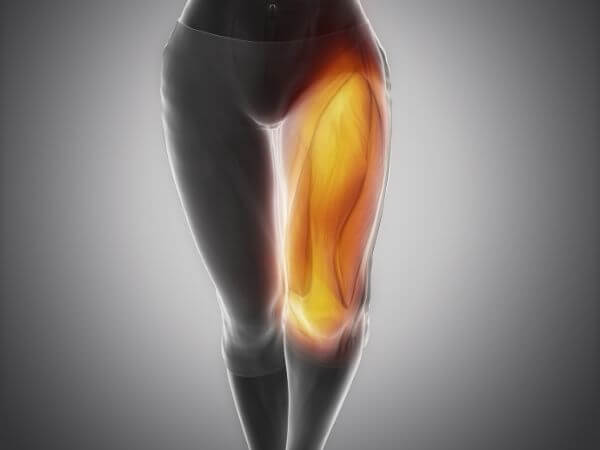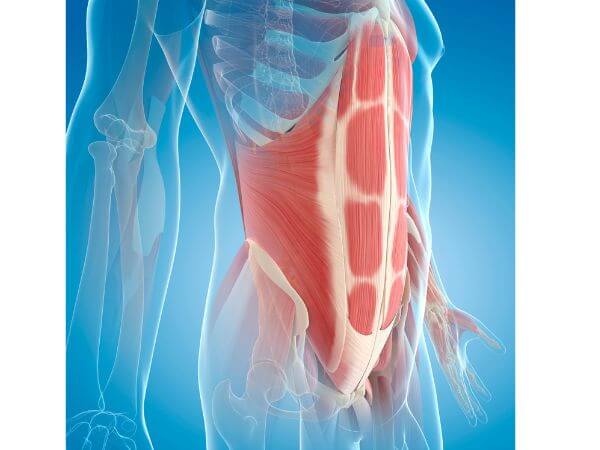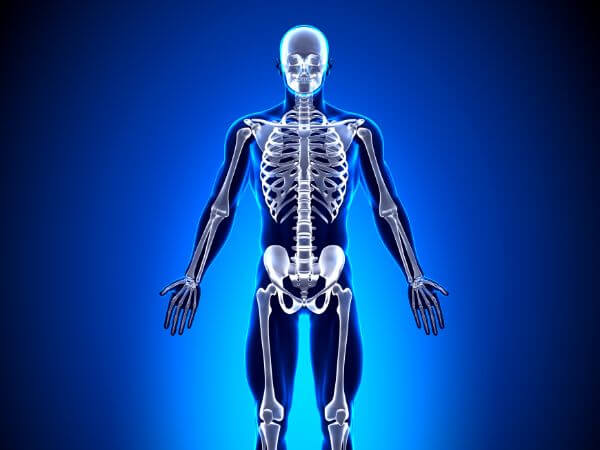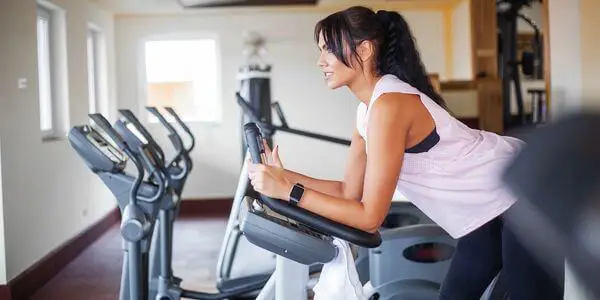Looking to tone up your body without spending hours in the gym?
Many people don’t realize that the exercise bike is a great way to work a variety of muscles. In fact, you can get a fantastic workout in just 30 minutes by cycling on an exercise bike.
You’ll be able to sculpt and tone your body while getting your heart rate up. Cycling is one of the best exercises for overall fitness, and it’s low impact, so it’s perfect for people who are just starting or have joint problems.
Read our article to learn more about how muscles are worked by an exercise bike! You’ll learn the science, the main differences between stationary bikes, and how to make the best out of your model.
Table of Contents
Muscles Worked by an Exercise Bike
Now, without any further ado, let’s get into the matter: which muscles do exercise bikes work?
1. Quadriceps

The quadriceps are a group of four muscles located in the front of the thigh. These muscles work together to extend the knee and are essential for walking, running, and climbing stairs.
Exercise bikes are an excellent way to strengthen the quadriceps because they allow you to target the muscles with specific exercises. For example, you can use resistance settings on an exercise bike to create resistance against your leg movement. This resistance helps to build muscle strength and endurance over time.
Exercise bikes also improve joint range of motion and flexibility. By working all four quadriceps muscles, exercise bikes provide a well-rounded workout that can help to improve your overall leg strength and function.
Exercise bikes aren’t created equal, though.
- Recumbent bikes work your quads the most when seated because of the elongated leg position. That’s compared to a typical upright bike.
- Spin bikes work your quads the most when you’re standing up. In this position, your upper body creates a lot of resistance too. That means your quads have to work harder.
- Assault bikes work your quads the most when pedaling at high speed. The reason is that increasing your speed on an assault bike also increases resistance. Therefore, you will work double as hard.
Tips for working your quads better on an exercise bike:
- Increase the resistance and speed – but that’s just obvious.
- Purchase a 2-in-1 stationary bike, depending on your other goals. For example, you can get a 2-in-1 upright bike that converts into a recumbent bike. Or a spin bike that can also be used upright.
- Wear a resistance band around your hamstrings. This strategy works well to increase your muscle mass, whether you’re standing or sitting. Make sure to wear the band at least a palm higher than your knees to avoid compressing your knee caps.
Read more: Recumbent Bike vs. Spin Bike
2. Hamstrings

The hamstrings are a group of three muscles that run along the back of the thigh. They are responsible for bending the knee and extending the hip.
Exercise bikes provide an excellent way to strengthen the hamstrings. Here’s why:
When pedaling, the hamstrings work to push the pedals backwards. The flywheel resists this action, causing the muscle to work harder. Over time, this resistance will result in stronger and more toned hamstrings.
Additionally, exercise bikes can be adjusted to provide a greater or lesser challenge, making them an ideal tool for both beginner and experienced athletes alike.
So whether you’re looking to improve your leg strength or want a low-impact workout, an exercise bike is a great choice.
- Recumbent bikes work your hamstrings the most when you’re seated compared to upright bikes. That’s also thanks to your extended leg position.
- Spin bikes work your hamstrings the best when you’re standing up. If you’re leaning over the handlebars, your hamstrings get an even more intense workout. If you’re not leaning over the handlebars, your quads will work harder.
- Assault bikes don’t target your hamstrings as much as the other two models above. However, increasing the speed and, therefore, the resistance will tone the back of your thighs more.
Tips for working your hamstrings better on an exercise bike:
- Increase the speed and resistance.
- Focus on positions that elongate and put pressure on the hamstrings, depending on your bike type. For example, lean over your spin bike’s handlebars or place your recumbent bike’s pedals slightly further than standard (without straining your lower back, obviously).
- Push through your heels instead of with your toes to activate the back of your thigh.
Read more: Recumbent Bike vs Upright Bike
3. Glutes

For many people, the exercise bike is a go-to choice for a workout. Not only is it low-impact, but it’s also relatively easy to use.
But did you know that an exercise bike can also be great for strengthening your glutes?
When you pedal, your glutes are engaged. The resistance thus created tones and tightens the muscles. In addition, most exercise bikes have adjustable resistance levels, so you can make your workout as challenging as you like.
So next time you hop on the exercise bike, remember that you’re not just burning calories – you’re also giving your glutes a workout.
- Recumbent bikes don’t work out your glutes as much as other stationary bikes because your position doesn’t allow your glutes to tense too much.
- Spin bikes work your glutes the most when you’re standing.
- Assault bikes work your glutes at an average level, but you can increase the burn by increasing the speed.
Tips for working your glutes better on an exercise bike:
- Stand up and pedal on your spin bike in a quarter squat position. You can also hold onto your handlebars to make things easier, but the point is pushing through your heels.
- Bring your recumbent bike’s pedals closer to your bum without compressing your knees. That way, you can engage your glutes more.
- Wear a resistance band around your hamstrings if you use a spin, assault, or upright bike.
Read more: 7 Best Exercise Machines for Bigger Glutes
4. Calves

Exercise bikes provide an excellent way to strengthen your calves. The pedaling motion works all of the muscles in your lower leg, including the calves.
Here’s how that works:
As you pedal, your calves must push against the pedals’ resistance. This resistance helps build muscle strength.
In addition, exercise bikes can be adjusted to provide more or less resistance so that you can tailor your workout to your specific needs.
By using an exercise bike regularly, you can help to improve the muscle tone and definition in your calves.
- Recumbent bikes offer a good challenge for your calves because you sit with your legs extended in front of you.
- Spin bikes target your calves the most, especially when you’re standing.
- Assault bikes are average in the calf-targeting department, but they still do excellent at the highest speeds.
Tips for working your glutes better on an exercise bike:
- Push through your tippy toes, whether you’re in a seated or standing position to activate those calves.
- Stand up on your spin bike whenever you can. To make things more challenging, you can wear a weighted vest.
- If your bike’s resistance isn’t as glorious as you’d like, you can wear ankle weights to target your calves and quads better.
Read more: Spin Bike Vs Stationary Bike: 7 Issues To Consider
5. Core Muscles

To understand how an exercise bike strengthens your core muscles, you must first understand what the core muscles are. And it’s not just your abs.
These muscles are located in the center of your body and include the abdominal muscles, back muscles, and hips.
The core muscles stabilize the spine and pelvis and control movement in the arms and legs. When these muscles are strong, they improve balance and posture, preventing back pain.
Here’s why riding an exercise bike is an excellent way to strengthen the core muscles:
The various motions involved in pedaling work all of the major muscle groups in the core. Besides, because you are sitting upright on the bike, it also helps to improve your posture.
As a result, regular bike riding can increase your strength, improve your balance, and reduce your risk of back pain.
- Recumbent bikes target the front of your abs better than other exercise bikes. Again, the reason is that you’re slightly leaning back when sitting on a recumbent bike. That means your abs will have to contract more to keep you stable.
- Spin bikes are best for targeting your lower back, especially when you’re standing. You’ll feel quite a burn in your lumbar area in this position – that’s why most beginners need to lean over their handlebars when they first use a spin bike. Don’t be discouraged and don’t force things, though; listen to your body to avoid injuring your lower back, and use your handlebars as often as you need to.
- Assault bikes offer average to low engagement in your core area, depending on your speed/resistance. You’ll notice that your obliques and lower back have to work harder at higher speeds, so include faster intervals in your workout.
Tips for working your core better on an exercise bike:
- Keep your abs contracted. That way, your core will have to work harder to keep you stable.
- Add some upper body exercises to your routine. For example, you can do quarter push-ups on the handlebars or overhead presses with dumbbells while pedaling. Don’t lift too much weight while you’re in motion. You need to be on solid ground for strength training your upper body. Remember that this tactic is just for strengthening your core, so 1-2-pound dumbells are all you need.
- Do intervals that alternate between high and low speeds/resistance. That way, your core muscles will have to adjust to the changes and work harder as a result.
Read more: Upright Bike Vs. Spin Bike: The Secrets Behind Choosing The Right Model
Bonus: Upper Body

Exercise bikes generally don’t target your arms, shoulders, and upper back too much. Upright and recumbent bikes have almost zero results in this.
If you want to sculpt your arms on an upright or recumbent bike, you should:
- Purchase a model with incorporated resistance bands.
- Use resistance bands of your own.
- Use free weights on your exercise bike. However, ensure you’re pedaling at a low speed and that these weights are light enough to control. You shouldn’t use weights as heavy as you would for a standalone strength training routine.
Spin bikes may engage your upper body more than upright bikes when you’re leaning over the handlebars. However, you will notice the biggest burn on your shoulders.
To make the most out of your spin bike, upper body-wise, remember to:
- Hold the handlebars with your hands instead of resting your elbows there. However, don’t overdo it to avoid shoulder pain.
- Keep your wrists straight to avoid injury.
- Slightly bend your elbows to get more engagement from your triceps.
- Pick a spin bike with incorporated upper body resistance bands.
Assault bikes offer a more effective upper body workout because you must push and pull the handlebars. Moving the arm forward targets your biceps and tips of your shoulder, whereas pulling the arm back engages your triceps and lats.
You should pedal faster to make the most of your assault bike. However, that increased speed may be brutal to handle if you haven’t yet built the necessary stamina.
Instead, you could:
- Wear wrist weights and pedal slower to get your arms to work harder.
- Use negative tension, which means contracting your arm muscles. Imagine you’re pushing through concrete to engage your arms even more and achieve the required tension to sculpt your arms.
Wrap Up
If you’ve made it here, you now know what muscles your exercise bike works the most and why. You also know the differences between different stationary bikes and how to make the most out of yours.
Following these tips can improve your muscle tone and definition, reducing your risk of injury. So what are you waiting for? Get out there and start pedaling!
As with any exercise routine, warm up before you start and cool down afterward. And always listen to your body; if something hurts, stop immediately.
- 7 Exercises for Pregnant Women in the First Trimester: Safe and Effective - January 30, 2025
- Our equipment recommendations - October 30, 2024
- Here’s What Doing Cardio Every Day Does To Your Body - August 21, 2024

